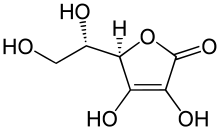User:Mr. Ibrahem/Vitamin C
Template:Good article is only for Wikipedia:Good articles.
 | |
 | |
| Clinical data | |
|---|---|
| Other names | l-ascorbic acid, ascorbic acid, ascorbate |
| AHFS/Drugs.com | Monograph |
| MedlinePlus | a682583 |
| License data | |
| Pregnancy category |
|
| Routes of administration | By mouth, IM, IV, subQ |
| Drug class | Vitamin |
| Legal status | |
| Legal status |
|
| Pharmacokinetic data | |
| Bioavailability | Rapid and complete |
| Protein binding | Negligible |
| Elimination half-life | Varies according to plasma concentration |
| Excretion | Kidney |
| Identifiers | |
| |
| Chemical and physical data | |
| Formula | C6H8O6 |
| Molar mass | 176.12 g·mol−1 |
| 3D model (JSmol) | |
| Density | 1.694 g/cm3 |
| Melting point | 190–192 °C (374–378 °F) (some decomposition)[2] |
| Boiling point | 552.7 °C (1,026.9 °F) [3] |
| |
| |
| (verify) | |
Vitamin C, also known as ascorbic acid and ascorbate, is a vitamin found in various foods and sold as a dietary supplement.[5] It is used to prevent and treat scurvy.[5] Vitamin C is an essential nutrient involved in the repair of tissue and the enzymatic production of certain neurotransmitters.[5][8] It is required for the functioning of several enzymes and is important for immune system function.[8][9] It also functions as an antioxidant.[10]
There is some evidence that regular use of supplements may reduce the duration of the common cold, but it does not appear to prevent infection.[10][6][11] It is unclear whether supplementation affects the risk of cancer, cardiovascular disease, or dementia.[12][13] It may be taken by mouth or by injection.[5]
Vitamin C is generally well tolerated.[5] Large doses may cause gastrointestinal discomfort, headache, trouble sleeping, and flushing of the skin.[5][6] Normal doses are safe during pregnancy.[1] The United States Institute of Medicine recommends against taking large doses.[8]
Vitamin C was discovered in 1912, isolated in 1928, and in 1933, was the first vitamin to be chemically produced.[14] It is on the World Health Organization's List of Essential Medicines.[15] Vitamin C is available as an inexpensive generic and over-the-counter medication.[5][16][17] Partly for its discovery, Albert Szent-Györgyi and Walter Norman Haworth were awarded the 1937 Nobel Prizes in Physiology and Medicine and Chemistry, respectively.[18][19] Foods containing vitamin C include citrus fruits, kiwifruit, guava, broccoli, Brussels sprouts, bell peppers and strawberries.[10] Prolonged storage or cooking may reduce vitamin C content in foods.[10]
References[edit]
- ^ a b "Ascorbic acid Use During Pregnancy". Drugs.com. Archived from the original on December 31, 2016. Retrieved December 30, 2016.
- ^ Merck Index, 14th ed.
- ^ "Vitamin C". ChemSpider. Royal Society of Chemistry. Archived from the original on July 24, 2020. Retrieved July 25, 2020.
- ^ "ASCORBIC acid = VITAMIN C oral - Essential drugs". medicalguidelines.msf.org. Archived from the original on August 27, 2021. Retrieved August 25, 2020.
- ^ a b c d e f g h "Ascorbic Acid". The American Society of Health-System Pharmacists. Archived from the original on December 30, 2016. Retrieved December 8, 2016.
- ^ a b c World Health Organization (2009). Stuart MC, Kouimtzi M, Hill SR (eds.). WHO Model Formulary 2008. World Health Organization. hdl:10665/44053. ISBN 9789241547659.
- ^ "WHOCC - ATC/DDD Index". www.whocc.no. Archived from the original on July 28, 2020. Retrieved September 15, 2020.
- ^ a b c "Vitamin C". Dietary Reference Intakes for Vitamin C, Vitamin E, Selenium, and Carotenoids. Washington, DC: The National Academies Press. 2000. pp. 95–185. ISBN 978-0-309-06935-9. Archived from the original on September 2, 2017. Retrieved September 1, 2017.
- ^ "Vitamin C". Micronutrient Information Center, Linus Pauling Institute, Oregon State University, Corvallis, OR. July 1, 2018. Archived from the original on July 12, 2019. Retrieved June 19, 2019.
- ^ a b c d "Fact Sheet for Health Professionals – Vitamin C". Office of Dietary Supplements, US National Institutes of Health. February 11, 2016. Archived from the original on July 30, 2017.
- ^ Hemilä H, Chalker E (January 2013). "Vitamin C for preventing and treating the common cold". The Cochrane Database of Systematic Reviews (1): CD000980. doi:10.1002/14651858.CD000980.pub4. PMC 1160577. PMID 23440782.
- ^ Ye Y, Li J, Yuan Z (2013). "Effect of antioxidant vitamin supplementation on cardiovascular outcomes: a meta-analysis of randomized controlled trials". PLOS ONE. 8 (2): e56803. Bibcode:2013PLoSO...856803Y. doi:10.1371/journal.pone.0056803. PMC 3577664. PMID 23437244.
{{cite journal}}: CS1 maint: unflagged free DOI (link) - ^ Duerbeck NB, Dowling DD, Duerbeck JM (March 2016). "Vitamin C: Promises Not Kept". Obstetrical & Gynecological Survey. 71 (3): 187–93. doi:10.1097/OGX.0000000000000289. PMID 26987583.
Antioxidant vitamin supplementation has no effect on the incidence of major cardiovascular events, myocardial infarction, stroke, total death, and cardiac death.
- ^ Squires, Victor R. (2011). The Role of Food, Agriculture, Forestry and Fisheries in Human Nutrition - Volume IV. EOLSS Publications. p. 121. ISBN 9781848261952. Archived from the original on December 25, 2020. Retrieved August 8, 2020.
- ^ World Health Organization (2019). World Health Organization model list of essential medicines: 21st list 2019. Geneva: World Health Organization. hdl:10665/325771. WHO/MVP/EMP/IAU/2019.06. License: CC BY-NC-SA 3.0 IGO.
- ^ British national formulary : BNF 76 (76 ed.). Pharmaceutical Press. 2018. p. 1049. ISBN 9780857113382.
- ^ "International Drug Price Indicator Guide. Vitamin C: Supplier Prices". Management Sciences for Health, Arlington, VA. 2016. Archived from the original on March 23, 2017. Retrieved March 22, 2017.
- ^ "The Nobel Prize in Physiology or Medicine 1937". Nobel Media AB. Archived from the original on November 5, 2014. Retrieved November 20, 2014.
- ^ Zetterström R (May 2009). "Nobel Prize 1937 to Albert von Szent-Györgyi: identification of vitamin C as the anti-scorbutic factor". Acta Paediatrica. 98 (5): 915–9. doi:10.1111/j.1651-2227.2009.01239.x. PMID 19239412.
